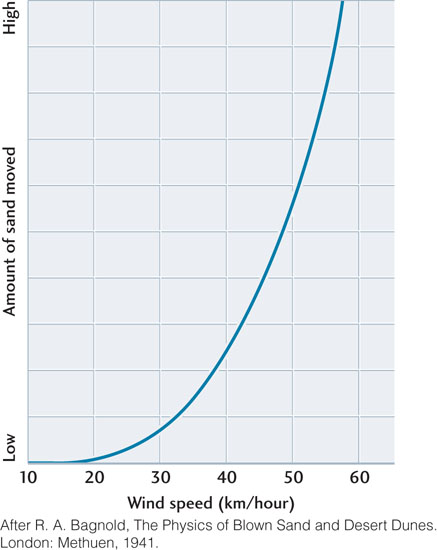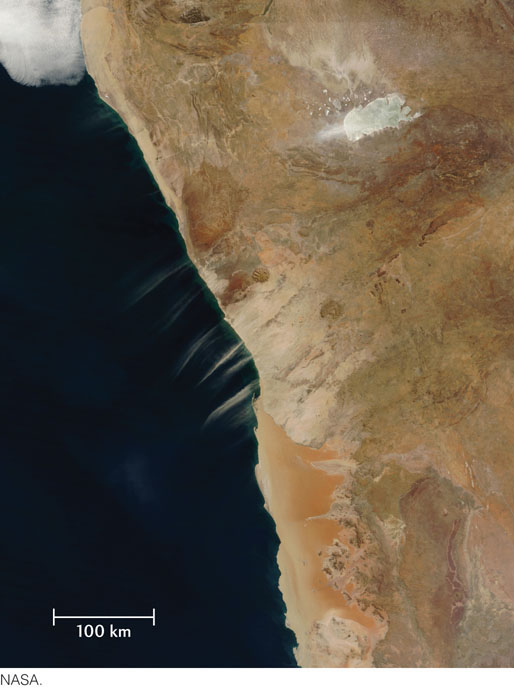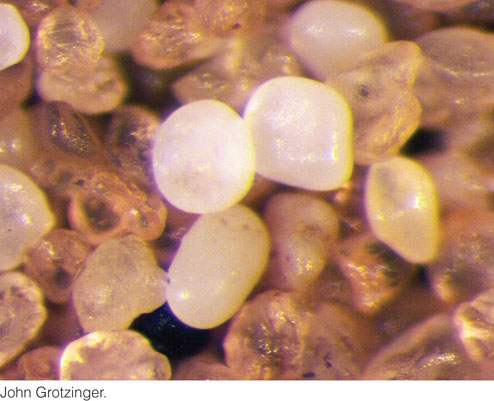Wind as a Transport Agent
Most North Americans are familiar with rainstorms or snowstorms: high winds accompanied by heavy precipitation. We may have less experience with dry storms, during which high winds blowing for days on end carry enormous amounts of sand and dust. The amount of material the wind can carry depends on the strength of the wind, the sizes of the particles, and the surface materials of the area over which the wind blows.
Wind Strength
Figure 19.2 shows the relative amounts of sand that winds of various speeds can erode from a 1-m-wide strip across a sand dune’s surface. A strong wind of 48 km/hour can move half a ton of sand (a volume roughly equivalent to two large suitcases) from this small surface area in a single day. At higher wind speeds, the amounts of sand that can be moved increase rapidly. No wonder entire houses can be buried by a sandstorm lasting several days!

Particle Size
The wind exerts the same kind of force on particles on the land surface as a stream exerts on particles on its bed. Like flows of water in streams, air flows are nearly always turbulent. As we saw in Chapter 18, turbulence depends on three characteristics of a fluid: velocity, flow depth, and viscosity. The extremely low density and viscosity of air make it turbulent even at the velocity of a light breeze. Thus, turbulence and forward motion combine to lift particles into the wind and carry them along, at least temporarily.
Even the lightest breezes carry dust, the finest-grained material. Dust usually consists of particles less than 0.01 mm in diameter (including silt and clay), but often includes somewhat larger particles. Moderate winds can carry dust to heights of many kilometers, but only strong winds can carry particles larger than 0.06 mm in diameter, such as sand grains. Moderate breezes can roll and slide these grains along a sandy bed, but it takes a stronger wind to lift them into the air current. Wind usually cannot transport particles larger than sand, however, because air has such low viscosity and density. Even though winds can be very strong, only rarely can they move pebbles in the way that rapidly flowing streams do.
Surface Conditions
Wind can lift sand and dust only from dry surface materials, such as dry soil, sediment, or bedrock. It cannot erode and transport wet soils because they are too cohesive. Wind can carry sand grains weathered from a loosely cemented sandstone, but it cannot erode grains from granite or basalt.
Materials Carried by Wind
As air moves, it picks up loose particles and transports them over surprisingly long distances. As we have seen, most of this material is dust, though sand can also be transported by wind.
532
Windblown Dust
Air has a staggering capacity to hold dust in suspension. Dust includes microscopic rock and mineral fragments of all kinds, especially silicates, as might be expected from their abundance as rock-forming minerals. Two of the most important sources of silicate minerals in dust are clays from soils on dry plains and volcanic ash from eruptions. Organic materials, such as pollen and bacteria, are also common components of dust. Charcoal dust is abundant downwind of forest fires; when found in buried sediments, it is evidence of forest fires in earlier geologic times. Since the beginning of the industrial revolution, humans have been pumping new kinds of synthetic dust into the air—from ash produced by burning coal to the many solid chemical compounds produced by manufacturing processes, incineration of wastes, and motor vehicle exhausts.
In large dust storms, 1 km3 of air may carry as much as a thousand tons of dust, equivalent to the volume of a small house. When such storms cover hundreds of square kilometers, they may carry more than 100 million tons of dust and deposit it in layers several meters thick. (See Earth Issues 19.1 for a discussion of similar dust storms on Mars.) Fine-grained particles from the Sahara have been found as far away as England and have been traced across the Atlantic Ocean to Florida. Wind annually transports about 260 million tons of material, mostly dust, from the Sahara to the Atlantic Ocean. Scientists on oceanographic research vessels have measured airborne dust far out to sea, and today it can be observed directly from space (Figure 19.3). Comparison of the composition of this dust with that of deep-sea sediments in the same region indicates that windblown dust is an important contributor to marine sediments, supplying up to a billion tons of material each year. A large part of this dust comes from volcanoes, and there are individual ash beds on the seafloor marking very large eruptions.

Volcanic ash is an abundant component of dust because much of it is very fine grained and is erupted high into the atmosphere, where it can travel farther than nonvolcanic dust blown by winds closer to Earth’s surface. Volcanic explosions inject huge quantities of dust into the atmosphere. The volcanic dust from the 1991 eruption of Mount Pinatubo in the Philippines encircled Earth, and most of the finest-grained particles did not settle until 1994 or 1995.
Mineral dust in the atmosphere increases when agriculture, deforestation, erosion, or other land-use changes disrupt soils. A large amount of the mineral dust in the atmosphere today may be coming from the Sahel, a semiarid region on the southern border of the Sahara where drought and overgrazing are responsible for a heavy load of dust.
Windblown dust has complex effects on the global climate. Mineral dust in the atmosphere scatters incoming visible light from the Sun and absorbs infrared energy radiated outward by Earth’s surface. Thus, mineral dust has a net cooling effect in the visible portion of the spectrum and a net warming effect in the infrared portion.
Windblown Sand
The sand transported by wind may consist of almost any kind of mineral grain produced by weathering. Quartz grains are by far the most common because quartz is such an abundant constituent of many surface rocks, especially sandstones. Many windblown quartz grains have a frosted or matte (roughened and dull) surface (Figure 19.4) like the inside of a frosted light bulb. Some of the frosting is produced by wind-driven impacts, but most of it results from slow dissolution by dew. Even the tiny amounts of dew found in arid climates are enough to etch microscopic pits and hollows into sand grains, creating the frosted appearance. Frosting is found only in eolian environments, so it is good evidence that a sand grain has been blown by the wind.

Most windblown sands are locally derived. Sand grains are typically buried in dunes after traveling a relatively short distance (usually no more than a few hundred kilometers), mainly by saltation near the ground. The extensive sand dunes of such major deserts as the Sahara and the wastes of Saudi Arabia are exceptions. In those great sandy regions, sand grains may have traveled more than 1000 km.
533
Earth Issues: 19.1 Martian Dust Storms and Dust Devils
Of all the planets in the solar system, Mars is the most like Earth. Although Mars has a thinner atmosphere, it has weather that changes seasonally and an Earthlike day of 24 hours and 37 minutes. Mars also has a complex surface environment including ice, soil, and sediment. As we saw in Chapter 9, it is almost certain that water once flowed on the Martian surface.
Today, Mars is cold and dry, and its surface environment is dominated by various eolian processes. These processes have created a variety of wind-sculpted landforms and deposited a wide variety of sediments. Sediments range from very widespread dust layers to more localized dune fields made up of sand and silt. Coarser deposits, composed of basaltic and hematitic granules, have been observed by the Mars Exploration Rovers. Planetary geologists estimate that the winds that produced these eolian deposits blew at velocities of up to 30 m/s (108 km/hour) during great dust storms that covered the entire planet (see Figure 9.19). Although these winds are not as fast as Earth’s strongest winds, and although Mars’s atmosphere is less dense than Earth’s, Martian winds are still strong enough to form an array of eolian depositional and erosional features identical to those observed on Earth. Even the pink color of the Martian atmosphere owes its origin to large quantities of windblown dust lifted into the atmosphere during dust storms.
As the seasons change on Mars, so does the weather. When the Mars Exploration Rover Spirit landed in January 2004, it explored the surface of Mars for months on end without seeing any evidence of recent eolian activity. However, in March 2005—more than a year after Spirit’s landing—its cameras began to observe dust devils in action, a sign that the seasons were changing. During the windy and dusty season, global dust storms are accompanied by local dust devils, which occur when the Sun heats the planet’s surface. Warmed soil and rocks heat the layer of the atmosphere closest to the surface, and the warm air rises in a whirling motion, stirring up the dust from the surface like a miniature tornado.
Martian dust storms and dust devils directly affect our ability to study the Martian surface. The rovers we’ve sent to Mars depend on solar power. Ultimately, the life span of the rovers is limited by the time it takes for enough windblown dust to settle on their solar panels and terminate power generation. Global dust storms contribute to the deposition of dust on the solar panels. Dust devils, however, are thought to help clean the dust off the solar panels when they move over the rovers, prolonging their useful lives.

Windblown calcium carbonate grains accumulate where there are abundant fragments of shells and coral, such as in Bermuda and on many coral islands in the Pacific Ocean. The White Sands National Monument in New Mexico is a prominent example of sand dunes made of gypsum sand grains eroded from evaporite deposits formed in nearby playa lakes (whose formation we will describe later in this chapter).
534